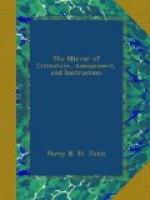“Believe, believe, when far away,
Distance but closer draws
the chain;
When twilight veils the ‘garish
day,’
Remembrance turns to thee
again.”
He’s gone!—but Fancy
in her ear
Still murmurs on his last
farewell,
While Hope dries in her eye the tear,
And bids her on each promise
dwell.
And long she hop’d—from
day to day,—
From early morn to dusky eve
Her thoughts were wand’ring far
away,
Nor deem’d that he could
e’er deceive.
Fond maid’—he thinks
no more on thee—
He mocks at thy enduring faith;
While the foul tongue of calumny
Accelerates thy early death.
This world to her a desert grew,
The sunny heavens no more
were fair;
Fast gathering tears obscured her view,
And only night’s dark
clouds were there.
Faded and chang’d the glorious dream,
The vision bright that floated
round her;
And death was in the ghastly gleam
That gave her eyes unearthly
splendour.
She lingered not, to feel that earth
Is rife with Disappointment’s
thorn—
That vows of faith are little worth,
And fleeting as the hues of
morn.
Farewell! farewell! pale lilies drooping
On her low bed as emblems
wave;—
And see!—the angel Pity stooping
To shed her tear on Fanny’s
grave!
Kirton Lindsey.
ANNE R.
* * * * *
THE “HALCYON” BIRD.
(To the Editor.)
The Halcyon is now only known by the name of the King Fisher (ispida, the alcedo ispida of Linnaeus), a very beautiful bird, frequenting waters, and feeding on fish. It builds in deep holes in the banks of rivers, and lays five, or, according to some, nine eggs. It much approaches to the Picus, or Woodpecker, in many points; but wants its great character, which is, the having two toes behind. The legs of this bird are very short, and are black before and red behind; its colours, particularly its green and blue, which are its general ones, are extremely bright and beautiful. It takes its prey after the manner of the Osprey, balancing itself at a certain distance over the water for a considerable space, and then darting below the surface, brings up the prey in its feet. While it remains suspended in the air, on a bright day, the plumage exhibits a most beautiful variety of very dazzling and brilliant colours.
This bird was called Halcyon by the ancients. Aristotle has described the bird and its nest; which, according to him, resembled those concretions that are formed by the sea water, and fashioned in the shape of a long necked gourd, hollow within, but so narrow at the entrance, that if it overset the water could not enter. This nest was called Halcyoneum, and had medical virtues ascribed to it: it was also




